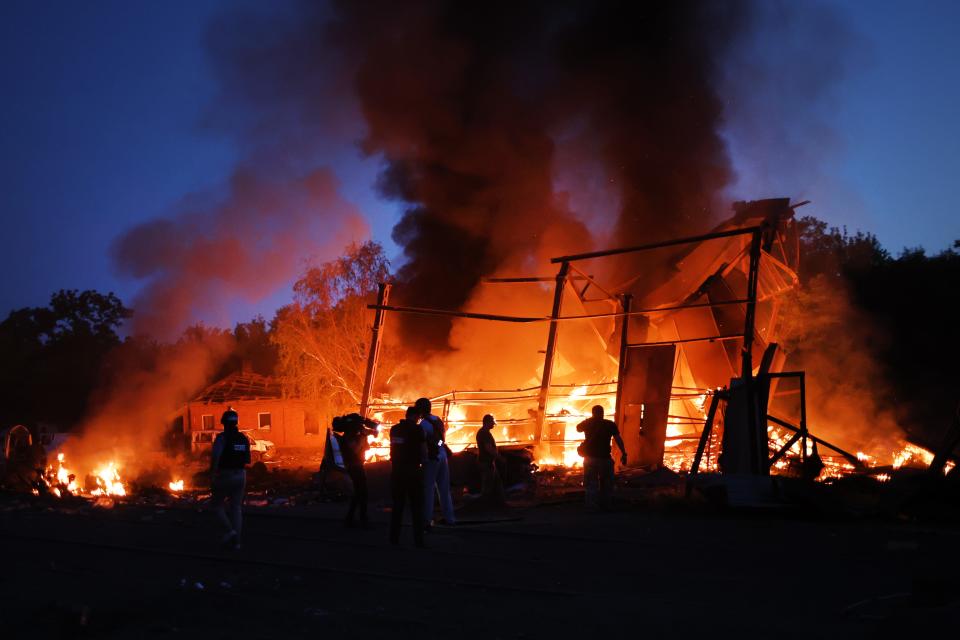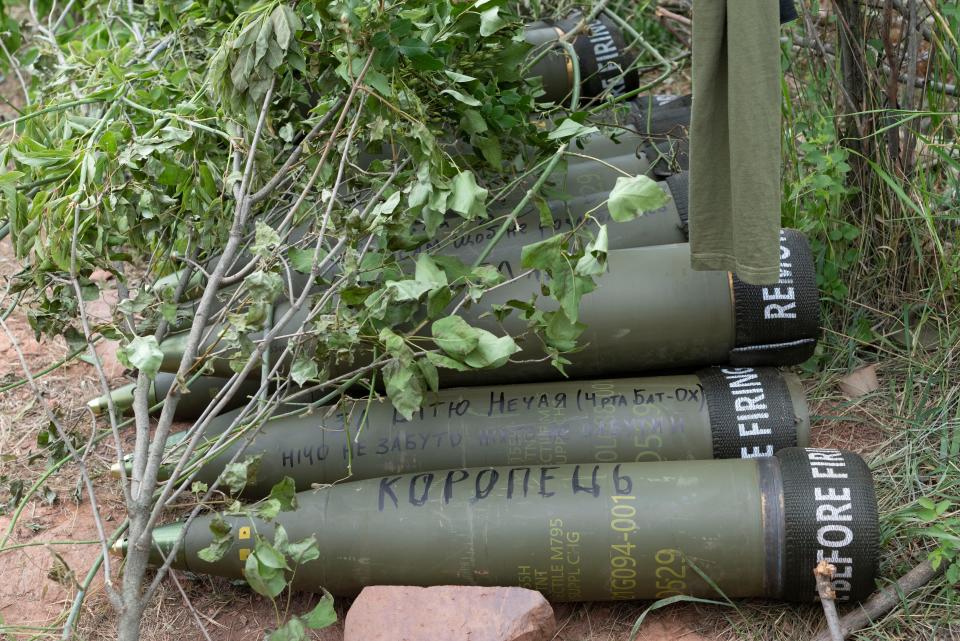'Two heavyweights that are just slugging it out': The new phase of Russia's war in Ukraine
- Oops!Something went wrong.Please try again later.
WASHINGTON – After its early military humiliation, Russia has regrouped in Ukraine and focused its wrath in the east with relentless shelling – giving Moscow momentum as the war moves into a bleak new phase.
In a war of attrition, Russia with its vast supply of artillery, armor and troops, now has an edge, military experts say. Ukraine still holds potent advantages of its own, according to a senior administration official: a fierce will to fight, firm command and control of its forces and increasingly sophisticated Western weapons.
Russia invaded its sovereign neighbor on Feb. 24 with the goal of quickly seizing the capital Kyiv and toppling Ukraine's democratically elected government led by Volodymyr Zelenskyy. But Russian troops were plagued by poor planning and low morale and faced stiffer-than-anticipated resistance from Ukraine's military, sparking Russia's recalibrated strategy focused on capturing territory in the east.
USA TODAY ON TELEGRAM: Join our Russia-Ukraine war channel to receive updates straight to your phone
The direction of the conflict will likely come into clearer focus over the summer. Here are key takeaways on the current state of the war, Russia and Ukraine's respective military advantages and vulnerabilities and what to look for next.
How has the war in Ukraine changed in recent weeks?
Combat in Ukraine has shifted to the eastern part of the country, its mineral-rich, industrial heartland. Since 2014, Russian-backed separatists have fought Ukrainian troops for control of the region known as the Donbas, which abuts Russia. That proximity has allowed Russia to avoid the problems of resupplying troops that doomed their initial attempt to take Kyiv in February.
Ukrainian forces used the forests of northern Ukraine around Kyiv to ambush the Russian columns that clung to established roads. After their retreat, the Russians have reconstituted battered battalion tactical groups, combat units that total about 700 to 1,000 soldiers. About 100 of those units are now in the Donbas, according to a senior administration official who was not authorized to speak publicly about the war and U.S. efforts to aid Ukraine.
The frontline of fighting extends more than 700 miles, winding south from near Kharkiv, Ukraine's second-largest city, toward Kherson and the Black Sea coast, said Seth Jones, director of the international security program at the Center for Strategic and International Studies, a Washington think tank.
"About 20% of Ukrainian territory has de facto been annexed," Jones said. "They’ve replaced currency with ruble in many areas, replaced the educational curriculum, including Russian history. The hand-picked local authorities are Russian."
'People are starving and thirsty':: As the US sends aid to Ukraine, some say it's not flowing fast enough
With relentless artillery shelling and reinforcements, the Russians have advanced toward the strategic Donbas city of Lysychansk, moving about three miles since June 19, according to a British Military Intelligence assessment released Thursday. Some Ukrainian troops have withdrawn from the area, probably to avoid being trapped.
But Russia's effort to consolidate its control of the Donbas, made up of the Luhansk and Donetsk, remains stalled, British military intelligence analysts concluded.

The open, rolling terrain in the region favors long-range weaponry. The Russians' strategy is to "soak" a target with massive volleys of artillery shells before making incremental advances by troops on the ground, the senior administration official said. The Ukrainians respond with artillery fire of their own, much of it coming from more than 100 M777 howtizer cannons supplied by the Pentagon.
"It's turned into a war of attrition," said Colin Smith, an expert on the Russian military at the Rand Corp. "And in a war of attrition, the force that has more forces tends to be more successful, right? Just sheer numbers."
Biden is giving Ukraine the deadliest weapons yet. Will it make a difference?
Russia's existing firepower vs. Ukraine new Western weapons
Russia, despite suffering devastating losses, still holds a significant edge in troops, armored vehicles and weaponry, the administration official said, including superior numbers of tanks, warplanes and artillery cannons. President Vladimir Putin's forces have retained the majority of their combat power, which included more than 150,000 troops Russia massed at Ukraine's border before the Feb. 24 invasion.
Russia's supply lines in the eastern part of Ukraine are shorter and more secure, avoiding the logistics problems that left its troops without food, fuel or event bullets outside Kyiv, Jones said.
"Now they have contiguous territory," Jones said. "Rail lines from Russia to the front that can bring artillery, tanks, infantry, ammunition."
On Ukraine's side of the ledger is the flow of increasingly sophisticated weaponry from the West. Long-range, rocket-assisted artillery – the High Mobility Rocket System – has a range of about 40 miles, more than double that of the M777 howitzer. Since the invasion, U.S. aid to Ukraine has totaled $5.6 billion in military aid. Since 2014, the United States has spent more than $8.3 billion on military aid to Ukraine.
The new U.S. rocket system has a pod of six rockets mounted on a truck that can speed away after launching an attack, a maneuver known as "shoot and scoot" that helps avoid counterattack. In mid-June, the Pentagon sent four high mobility rocket systems launchers to Ukraine, and officials noted that it would take a few weeks to train their troops on how to fire them, a timeline that could put them on the battlefield soon.
“The pivotal moment will come when our armed forces use Western-provided multiple launch rocket systems to destroy Russia’s artillery, turning the tide in Ukraine’s favor along the entire frontline,” Ukraine’s foreign minister, Dmytro Kuleba, predicted in a recent Foreign Affairs op-ed. “Afterward, our troops will aim to take back pieces of land, forcing Russians to retreat here and there.”
HIMARS have arrived to Ukraine.
Thank you to my 🇺🇲 colleague and friend @SecDef Lloyd J. Austin III for these powerful tools!
Summer will be hot for russian occupiers. And the last one for some of them. pic.twitter.com/BTmwadthpp— Oleksii Reznikov (@oleksiireznikov) June 23, 2022
The $1 billion shipment of arms in June also included launchers for powerful Harpoon anti-ship missiles to protect the portion of Ukraine's Black Sea coast not occupied by Russia, including the strategic port city of Odesa. Other Western nations are supplying Ukraine with the missiles, which were recently used to sink a ship ferrying supplies and troops to reinforce Snake Island, which Russia occupied early in the war.
The new weapons offer Ukraine the ability to strike from greater distance, outside the range of some Russian artillery, the administration official said. Command posts or ships located at what had been safe remove also are now vulnerable to attack.
Less tangible, but at least as important, is high morale among Ukrainian troops, the administration official said. They continue to fight, and take back territory, from Russian forces. Though outnumbered, Ukraine has better quality soldiers than the Russians, and better leadership, the official said.
Russian ineptitude has also redounded to Ukraine's favor, according to the official and analysts. Russia has failed to coordinate its military assault among its ground, air and artillery forces.

"I would have thought they would have been able to fight an integrated fight much better than they have," Smith said. "Their command and control has been dismal."
Ukrainian competence and Russia's lack of it have had steep costs for Putin. Thousands of Russian soldiers have been killed over about four months of fighting, and tens of thousands more have been wounded, the official said. More than 1,000 Russian tanks have been destroyed or heavily damaged along with 1,700 armored personnel carriers and 400 artillery pieces.
"They haven't really recovered from the initial intelligence failure of going into Ukraine in the first place," Smith said. "They thought parts of Ukraine would welcome them with open arms. Instead, they ran into a fight that they weren't prepared to fight."
Ukrainian losses have been steep, too. Army Gen. Mark Milley, chairman of the Joint Chiefs of Staff, said last week in Brussels that reports of Ukraine losing 100 troops per day and hundreds more wounded are probably accurate.
A boxing match? What to look for next
Over the summer, Russia is likely to attempt to consolidate its gains in the Donbas region. If successful, experts say, Putin could declare victoryand seek to hold the territory Russia has seized.
"Now that puts the onus on Ukraine to counterattack and it will be easier for Russia to defend," Smith said.
It's possible that Ukrainian forces could buckle under overwhelming artillery attacks, Smith said, allowing Russians to pour through a gap in the frontline and advance further west.
But neither Smith or Jones believe Russia has the ability to occupy a significant portion of Ukraine. Local resistance, the steady flow of Western arms and Russian incompetence suggest they'll have difficulty holding ground.
Buoyed by Western support, Ukraine also appears unlikely to concede territory. For now, it's a war of attrition.
"You could equate it to boxing," Smith said. "You have got two heavyweights that are just slugging it out. Who's able to do better in the later rounds?"
Don't bet against Ukraine, the official said. They have continually defied expectation.
This article originally appeared on USA TODAY: Ukraine war: Russia has gained momentum with new strategy in the east

